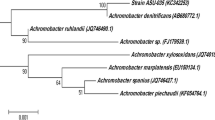Abstract
Pseudomonas putida E41 was isolated from oil-contaminated soil and showed its ability to grow on ethyl-benzene as the sole carbon and energy source. Moreover, P. putida E41 show the activity of biodegradation of ethylbenzene in the batch culture. E41 showed high efficiency of biodegradation of ethylbenzene with the optimum conditions (a cell concentration of 0.1 g wet cell weight/L, pH 7.0, 25°C, and ethylbenzene concentration of 50 mg/L) from the results of the batch culture. The maximum degradation rate and specific growth rate (μmax) under the optimum conditions were 0.19+0.03 mg/mg-DCW (Dry Cell Weight)/h and 0.87+0.13 h−1, respectively. Benzene, toluene and ethylbenzene were degraded when these compounds were provided together; however, xylene isomers persisted during degradation by P. putida E41. When using a bioreactor batch system with a binary culture with P. putida BJ10, which was isolated previously in our lab, the degradation rate for benzene and toluene was improved in BTE mixed medium (each initial concentration: 50 mg/L). Almost all of the BTE was degraded within 4 h and 70–80% of m-, p-, and o-xylenes within 11 h in a BTEX mixture (initial concentration: 50 mg/L each). In summary, we found a valuable new strain of P. putida, determined the optimal degradation conditions for this isolate and tested a mixed culture of E41 and BJ10 for its ability to degrade a common sample of mixed contaminants containing benzene, toluene, and xylene.
Similar content being viewed by others
References
Abuhamed, T., E. Bayraktar, T. Mehmetoglu, and U. Mehmetoglu. 2004. Kinetics model for growth of Pseudomonas puitda F1 during benzene, toluene and phenol biodegradation. Proc. Biochem. 39, 983–988.
Assinder, S.J. andP.A. Williams. 1990. The TOL plasmids: determinants of the catabolism of toluene and xylenes. Adv. Microb. Physiol 31, 1–69.
Attaway, H.H. and M.G. Schmidt. 2002. Tandem biodegradation of BTEX components by two Pseudomonas sp. Curr. Microbiol. 45, 30–36.
Bielefeldt, A.R. andH.D. Stensel. 1999. Modeling competitive inhibition effects during biodegradation of BTEX mixtures. Wat. Res. 33, 707–714.
Blume, H.P. 1990. Handbuch des Bodenschutzes. Landsberg: Ecomed.
Bordel, S., R. Munoz, L.F. Diaz, and S. Villaverde. 2007. New insights on toluene biodegradation by Pseudomonas putida F1: influence of pollutant concentration and excreted metabolites. Appl. Microbiol. Biotechnol. 74, 857–866.
Burback, B.L. andJ.J. Perry. 1993. Biodegradation and biotransformation of groundwater pollutant mixtures by Mycobcteriumvaccae. Appl. Environ. Microbiol. 59, 1025–1029.
Chang, S.W., H.J. La, and S.J. Lee. 2001. Microbial degradation of benzene, toluene, ethylbenzene and xylene isomers (BTEX) contaminated groundwater in Korea. Water Sci. Technol. 44, 165–171.
Cox, D.P. andC.D. Goldsmith. 1979. Microbial conversion of ethylbenzene to 1-phenethanol and acetophenone by Nocardiatartaricans ATCC 31190. Appl. Environ. Microbiol. 38, 514–520.
Deeb, R.A. andL.A. Cohen. 1999. Temperature effects and substrate interactions during the aerobic biotransformation of BTEX mixtures by toluene-enriched consortia and Rhodococcusrhodochrous. Biotechnol. Bioeng. 62, 526–536.
Lapertot, M., C. Seignez, S. Ebrahimi, S. Delorme, and P. Peringer. 2007. Mass production of bacterial communities adapted to the degradation of volatile organic compounds (TEX). Biodegradation 18, 343–350.
Lee, K. andD.T. Gibson. 1996. Toluene and ethylbenzene oxidation by purified naphthalene dioxygenase from Pseudomonas sp. Strain NCIB 9816-4. Appl. Environ. Microbiol. 62, 3101–3106.
Lee, E.Y., Y.S. Jun, S.C. Kyung, and H.R. Ryu. 2002. Degradation characteristics of toluene, benzene, ethylbenzene and xylene by stenotrophomonasmaltophilia T3-c. J. Air Waste Manage. Assoc. 52, 400–406.
Leiwandowski, J., S. Leitschun, and V. Kob. 1997. SchadstoffeimBonden. Springer, Berlin, Germany.
Li, H., Y.H. Liu, N. Luo, X.Y. Zhang, T.G. Luan, J.M. Hu, Z.Y. Wang, P.C. Wu, M.J. Chen, and J.Q. Lu. 2006. Biodegradation of benzene and its derivatives by a psychrotolerant and moderately haloalkaliphilic Planococcus sp. strain ZD22. Res. Microbiol. 157, 629–636.
Margesin, R., G. Walder, and F. Schinner. 2003. Bioremediation assessment of a BTEX-contaminated soil. Acta Biotechnol. 1, 29–36.
Parameswarappa, S., C. Karigar, and M. Nagenahalli. 2007. Degradation of ethylbenzene by free and immobilized Pseudomonas fluorescens-CS2. Biodegradation 10.1007/s10532-007-9121-y.
Plaza, G.A., J. Wypych, C. Berry, and R.L. Brigmon. 2007. Utilization of monocyclic aromatic hydrocarbons individually and in mixture by bacteria isolated from petroleum contaminated soil. World J. Mocrobiol. Biotechnol. 23, 533–542.
Sasser, M. 1990. Identification of bacteria through fatty acid analysis, pp. 199–204. In Z. Klement, K. Rudolph, and D.C. Sands (eds.), Methods in phytobacteriology, AkademiaiKiado, Budapest, Hungary.
Singleton, I. 1994. Microbial metabolism of xenobiotics: fundamental and applied research. J. Chem. Technol. Biotechnol. 59, 9–23.
Utkin, I.B., M.M. Yakimov, L.N. Matveeva, E.I. Kozlyak, I.S. Rogozhin, Z.G. Solomon, and A.M. Bezborodov. 1990. Degradation of styrene and ethylbenzene by Pseudomonas species Y2. FEMS Microbiol. Lett. 77, 237–242.
Wang, L.T., C.J. Tai, Y.C. Wu, Y.B. Chen, F.L. Lee, and S.L. Wang. 2010. Pesudomonas taiwanensis sp. nov., isolated from soil. Int. J. Syst. Evol. Microbiol. 60, 2094–2098.
Author information
Authors and Affiliations
Corresponding author
Rights and permissions
About this article
Cite this article
Kim, LH., Lee, SS. Isolation and characterization of ethylbenzene degrading Pseudomonas putida E41. J Microbiol. 49, 575–584 (2011). https://doi.org/10.1007/s12275-011-0399-4
Received:
Accepted:
Published:
Issue Date:
DOI: https://doi.org/10.1007/s12275-011-0399-4




